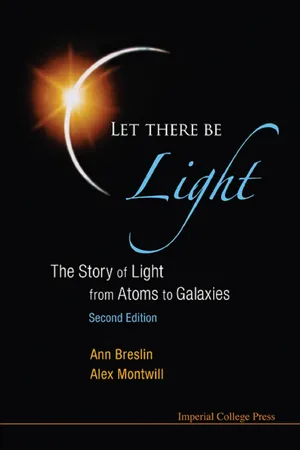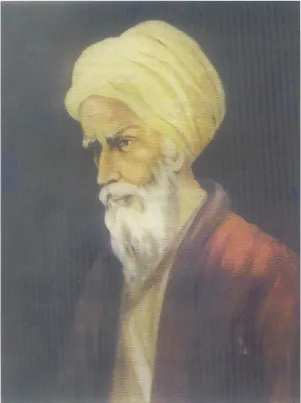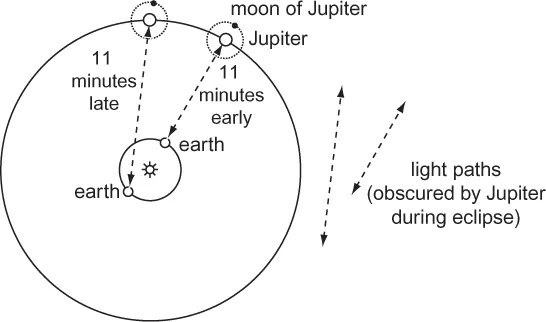![]()
Chapter 1
Introducing Light
Light plays a central role in our lives. It is the universal messenger which enables us to be aware of the objects around us and of the rest of the universe. Without light we would not receive the life-giving energy from the sun. Much more than that, light or electromagnetic radiation is at the centre of the physical laws. Without it the universe, as we have come to know it, would simply not exist!
Visible light forms only a tiny part of the electromagnetic spectrum. Our eyes are sensitive to a certain range of wavelengths of that spectrum, but not to gamma rays, X-rays, radio waves, or to infrared and ultraviolet radiation.
Light travels at a speed which is almost beyond our imagination. In this chapter we describe the early methods of measuring that speed. We also discuss the wonderful process of vision, how our eyes can distinguish colour and our brains can reconstruct an image.
The remainder of this chapter gives a preview of the rest of the book. The story is an exciting one, full of the unexpected, teaching us that we must accept nature as it is, not as we think it should be.
A major surprise came in the year 1900, when Max Planck proposed that light can have only certain quantized values of energy — a precursor of the extraordinary property of the duality of light. This means that it has apparently contradictory attributes: sometimes it behaves as a particle, and at other times it behaves as a wave. This property of light was the first clue to the very basic quantum laws of nature, which were revealed when Niels Bohr and his collaborators probed into the ‘world of the very small’.
1.1 The perception of light through the ages
Philosophers throughout the ages have struggled to explain exactly what light is and why it behaves as it does. It was not always realized that we see luminous objects, such as candles and the sun, because they emit light and the eye receives that light. We also see many other objects, such as the moon, trees, and each other, simply because the light from a luminous object like the sun is reflected from them. We can gaze into each other’s eyes not because they are luminous, but because they reflect light which originally came from the sun and perhaps, on the way, had been reflected by the moon!
The ancient Greeks
The Greek philosophers from as early as Pythagoras (c. 582 BC–c. 497 BC) believed that light came from ‘visible’ things and that our eyes received the tiny particles of light. The philosopher and statesman Empedocles (5th century BC), originator of the idea of four elements — earth, air, fire and water (and two moving forces, love and strife) — also made a number of assertions about light. He believed that light came from luminous objects but that light rays also came out from the eyes. In addition, he proposed that light travels at a finite speed.
The Greek mathematician Euclid (c. 325 BC–c. 265 BC), perhaps better known for his works on geometry, is also believed to have thought that the eyes send out rays of light and that this gives the sensation of vision. Euclid studied mirrors, and the law of reflection is stated in a book entitled Catoptrics, thought to have been written by him in the 3rd century BC.
The middle ages
Ibn Al-Haitham (965–1040) did not accept the theory that objects are seen by rays emanating from the eyes and maintained that light rays originate at the objects of vision. He studied the passage of light through various media and carried out experiments on the refraction of light as it crossed the boundary between two media. He became known as ‘the father of modern optics’ and was the author of many books — one of the best-known, Kitab Al-Manathr, was translated into Latin in the Middle Ages. It speculated on the physical nature of light, described accurately the various parts of the eye, and was the first to give a scientific expla nation of the process of vision. This was a monumental work, based on experiment rather than dogmatism.
Ibn Al-Haitham. Courtesy of The Pakistan Academy of Sciences.
René Descartes (1596–1650) considered light as a sort of pressure transmitted through a mysterious elastic medium called the ether, which filled all space. The remarkable diversity of colours was attributed to rotary motions of the ether.
Galileo Galilei (1564–1642) developed the experimental method and prepared the way for a proper investigation of the properties of light. The transmission of light had been thought to be instantaneous but Galileo tried to measure the speed of light by putting two people on hills separated by about a mile. One opened a lantern and the other raised his hand when he saw the light. No time difference was detected, which is not surprising since the time interval, based on the currently accepted speed of light, would have been about five microseconds. (There are one million microseconds in one second.)
The law of reflection was known to the ancient Greeks. To put it simply, it says that light is reflected from a surface at an angle which is symmetrically opposite to the angle at which it came in.
The law of refraction was discovered experimentally in 1621 by the Dutch mathematician Willebrord Snell (1580–1626). It deals with what happens when light goes from one medium into another. Snell observed that light changes direction abruptly when it crosses the boundary between two materials. He discovered that the degree of bending depends only on the materials themselves and not on the angle at which the light strikes the boundary. His work was stated in the well-known law of refraction, named after him.*
Snell died in 1626, without publishing his result. The first mention of it appeared in the Dioptrique by René Descartes, without reference to Snell, but it is generally believed that Descartes had in fact seen Snell’s unpublished manuscript.
The laws of reflection and refraction are the basis of the whole of geometrical optics and form the subject matter of Chapters 2 and 3. Both these laws can, in turn, be derived from an even more fundamental law — discovered by the French mathematician Pierre de Fermat (1601–1665) — formulated as the principle of least time. (For a biographical note on Fermat see ‘A historical interlude’ at the end of the next chapter.)
1.2 Colours
The visible spectrum
In 1666, Isaac Newton showed that white light is made up of a continuous spectrum of colours, from red to orange, yellow, green and finally to blue, indigo and violet. He passed a beam of sunlight through a prism, and saw it fan out into its constituent colours. By putting a piece of paper on the far side of the prism, he was able to look at ‘individual’ colours. He was able to recreate white light by bringing the colours together again using a second prism.
The figure below is a schematic representation, in that one would not normally see the spectral colours by looking at the beam from the side. In addition, principally owing to the finite width of the incoming beam, it is not possible to recombine the colours completely. In practice, the final image is white in the centre with a combination of colours on each side.
Visible part of electromagnetic spectrum.
Newton’s experiment with prisms.
1.3 Measuring the speed of light
The astronomical method
In 1676, the Danish mathematician Olaus Römer (1644–1710) found that eclipses of Jupiter’s moons do not occur at the times predicted by Newtonian mechanics. They are about 11 minutes too early when Jupiter is closest to the earth and about 11 minutes too late when it is furthest away. Römer concluded that the discrepancy occurs because light takes longer to travel the larger distance (as indicated above), and on the basis of the measured time difference of about 22 minutes, he calculated the speed of light to be 2.14 × 108 m/s. Although not a particularly good estimate in modern times, this value is certainly of the right order of magnitude and a remarkable achievement at the time.
Jupiter’s moons. The light message takes longer when Jupiter is further away.
Terrestrial measurement
In 1849, the French physicist Hyppolyte Fizeau (1819–1896) made the first terrestrial measurement of the speed of light, in a simple but ingenious way.
In Fizeau’s experiment, light from a source was focused onto the rim of a rotating wheel, cut with very fine teeth. The light passing between the teeth was reflected from a mirror and retraced its path, as shown in the schematic diagram below.
The source, obj...




